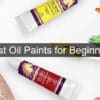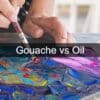How to Get Pencil Off Canvas

Are you struggling to remove pencil marks from a canvas? If so, this is the post for you.
Below, we’ve outlined the best methods that you can use to remove pencil lines and marks to pastel pencils from canvas materials quickly and easily. By the end, you’ll have a better sense of the best practices involved with erasing pencil lines so that it is no longer an issue.
Rubbing Alcohol
- Combine rubbing alcohol with water in a spray bottle.
- Make sure that the solution is half alcohol and half water.
- Spray the solution directly onto the canvas.
- Use a dry cloth to wipe the surface and erase the marks.
Palette Knife
- Be careful when using a palette knife to remove sketch marks from a canvas surface.
- Make sure to hold the knife going in the same direction as the grain of the canvas.
- Gently scrape the markers until you remove the pencil lines.
- If you don’t go in the same direction as the canvas, you may end up creating lines on your painting that are more difficult to remove from a stretched canvas.
Rulers
- Similarly to the palette knife method, use a rule to gently scrape the pencil marks in the same direction as the canvas grain.
- Apply the rules gently to avoid scraping off any paint.
Blender Pencils
- Blender pencils are made specifically for erasing pencil and graphite pencil mistakes from a drawing.
- Color in the mark using the blender pencil and rub it gently until the mark is completely gone.
Razor Blade
- Slide the blade along the pencil lines gently to avoid damaging your canvases.
- Repeat the process being careful not to scrub too hard to avoid scratching off the acrylic paint, watercolor pencil, or ink.
Dry Erase Marker
- Once you’ve found the lines that you want to get rid of, sketch over them.
- Use your dry-erase marker to rub over the covered areas until the marks begin to disappear.
- Use paper towels to clean the area and remove any eraser dust.
Blotter Paper
- Start by tearing your blotter paper into pieces and rolling them up.
- Place them into storage nearby so that they can be used at any time during your artwork.
- You can then use a piece of this paper for erasing pencil marks.
Solvent
- A solvent can be effective at removing sketch pencil marks. However, you may want to apply a small amount to a clean portion of the canvas to make sure that it doesn’t react badly.
- If there’s no bad reaction, apply the solvent to a cotton ball and use a small brush to gently scrub the sketch line until it disappears.
- You can then use a paper towel or dry cloth to wipe the painted surface clean.
Also read: How to Sketch With Colored Pencils
Conclusion
So, that concludes our post on how to effectively remove pencil marks from a canvas. The next time you notice a pencil mark on your oil painting that you want to remove, try implementing one of the tips above to remove it quickly and easily.
FAQs
What are some other methods to remove colored pencils from canvas?
You could try using a kneadable eraser. Kneaded erasers are a gentle way of removing graphite pencils from acrylic and oil paint without damaging them.
Affiliate Disclosure
In compliance with the FTC guidelines, please assume the following about all links, posts, photos and other material on this website: Any/all of the links on this website are affiliate links of which The Big Red Illustration Agency receives a small commission from sales of certain items, but the price is the same for you. www.bigredillustrationagency.com is a participant in the Amazon Services LLC Associates Program, an affiliate advertising program designed to provide a means for sites to earn advertising fees by advertising and linking to Amazon.com & Amazon.co.uk. Pages on this site may include links to Amazon and its affiliate sites on which the owner of this website will make a referral commission.
FULL TERMS HERE Cookie preferences: cookie preferences

Written By Adam Rushton
Adam has made a name for himself in the illustration industry and is a passionate blogger and writer on the subject of art, illustration and graphic design.
His artwork has been featured in countless publications and used for very well-known media projects. As a professional illustrator for over 20 years, Adams media outlets, a wealth of knowledge, and experience enable him to consult and advise artists and illustrators in this country (from York and Manchester to Southampton and London) and all over the world.



































